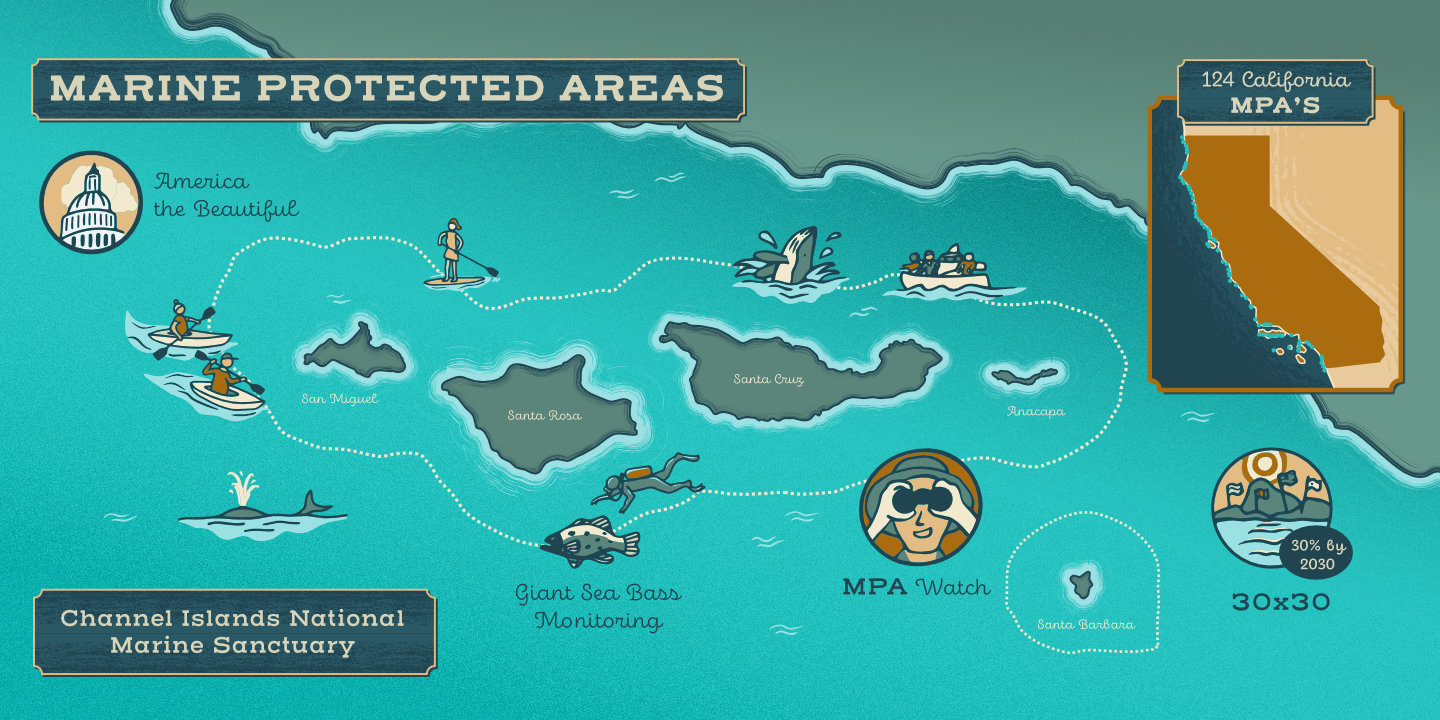
Conservation Corner
Marine Protected Areas
Places of Restoration and Recovery for the Ocean
Marine Protected Areas serve as a critical tool in the conservation of marine habitats. Explore the questions below to discover and learn.
What is an MPA?
A marine protected area (MPA) is a “defined region designated and managed for the long-term conservation of marine resources, ecosystems services, or cultural heritage.” It is an effective conservation tool to restore natural habitats and the associated species by managing human activities. There are many other terms which have similarities or overlap with MPAs, including marine reserve, marine park, marine sanctuary, marine national monument, and others.
A frequent misconception is that MPAs do not allow ANY access; this is generally not the case. Activities, like kayaking, snorkeling, paddleboarding, swimming, boating, and other uses that do not harm the animals, plants, and water quality, are often allowed in MPAs.
The demonstrated benefits of MPAs are restoration of the local animal and plant populations. MPAs have more animals and plants, which tend to be bigger and healthier, than unprotected areas. This wealth typically does not just stay in that one place. Many of the animals travel outside of the MPA, increasing the abundance and biodiversity in adjacent areas. The protection also can increase local economic activity by enhancing tourism in the area.
There must be a lot of MPAs, right?
California has been active in adopting MPAs. In 1999 the state embarked upon a comprehensive approach to marine conservation off our coast that established a network of 124 MPAs. Monitoring of the species within the protected areas is done annually, and earlier this year a decadal review was published documenting the impacts of the network.
You may have heard more talk in the last few years about MPAs. This is because in early 2021 President Biden signed an executive order committing to conserving “at least 30 percent of our lands and waters by 2030.” Shortly thereafter the federal government released its plan for how to achieve this target in the “America the Beautiful” report and shares progress annually.
The U.S. is not the only country to pursue this lofty goal; globally this pledge is colloquially known as “30x30.” Dozens of countries or smaller jurisdictions, like the state of California, have committed to it.
What does the Aquarium do to help MPAs?
The Aquarium’s work regularly intersects with MPAs.
- In the past we have hosted forums to discuss the placement of protected areas off the California coast.
- We have an active partnership with the Channel Island National Marine Sanctuary to support giant sea bass monitoring, white abalone conservation, and other research.
- Our divers participate in monitoring programs within (and outside) of protected areas collecting data so that decision-makers can track habitat and animal changes over time and make informed choices about the future.
- The Aquarium also features protected areas in our galleries so that every visitor has the opportunity to become more familiar with MPAs and where they might encounter them.
How can I help MPAs?
You too can be involved with the California network of MPAs beyond being a casual visitor. MPAWatch is a community science initiative through which individuals are trained to collect data on human use of MPAs and adjacent areas. The data are used to help inform managers, as well as contribute to scientific research.
You can also support the state’s MPAs by being an informed steward – knowing what rules or restrictions exist in the areas that you are visiting and adhering to them. Check out the state’s comprehensive resource page or get involved in a local MPA.
- Paddleboarding - (12.00%)
- Swimming - (24.00%)
- Boating - (12.00%)
- Kayaking - (8.00%)
- Snorkeling - (36.00%)

Jennie Dean
Jennie Dean is the Aquarium’s inaugural vice president of education and conservation. She focuses on the amplification and enhancement of the Aquarium’s work in species conservation and learning for all audiences. Previously Dean was a program director at the University of California, Los Angeles’ Institute of the Environment and Sustainability, where she oversaw programs engaging the private sector on corporate sustainability and consulted with island governments on sustainable development of their blue economy.